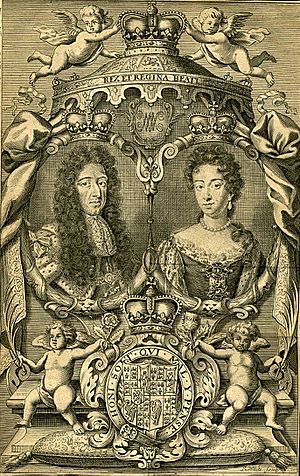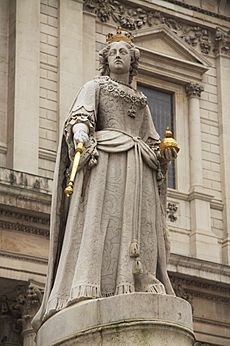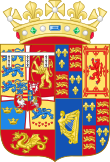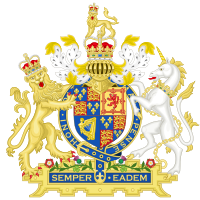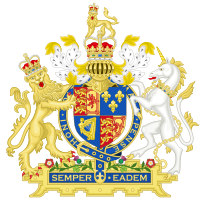Anne, Queen of Great Britain facts for kids
Quick facts for kids Anne |
|
|---|---|

Portrait by Michael Dahl, 1705
|
|
| Queen of England, Scotland, and Ireland | |
| Reign | 8 March 1702 – 1 August 1714 |
| Coronation | 23 April 1702 |
| Predecessor | William III & II |
| Successor | George I |
| Born | 6 February 1665 St James's Palace, Westminster, Middlesex, England |
| Died | 1 August 1714 (aged 49) Kensington Palace, Middlesex, Great Britain |
| Burial | 24 August 1714 Westminster Abbey |
| Spouse | |
| Issue more... |
Prince William, Duke of Gloucester |
| House | Stuart |
| Father | James II & VII |
| Mother | Anne Hyde |
| Religion | Anglican |
| Signature |  |
Anne (born 6 February 1665 – died 1 August 1714) was a very important queen. She ruled England, Scotland, and Ireland starting on 8 March 1702. On 1 May 1707, something big happened: England and Scotland joined together. This created a new country called Great Britain. Queen Anne then ruled Great Britain and Ireland until she died in 1714.
Anne was born when King Charles II was on the throne. Her father, James, was the king's younger brother. Many people in England did not like that James was a Roman Catholic. King Charles made sure Anne and her older sister Mary were raised as Anglicans (Protestants).
Mary married a Dutch Protestant prince, William III of Orange, in 1677. Anne married Prince George of Denmark in 1683. When King Charles died in 1685, James became king. But just three years later, he was removed from power in the Glorious Revolution of 1688. Mary and William then became joint rulers.
Anne and Mary used to be close, but they had disagreements. These were about Anne's money, her royal status, and her friends. This made them grow apart. William and Mary did not have any children. After Mary died in 1694, William ruled alone. When he died in 1702, Anne became queen.
During her time as queen, Anne usually supported Tory politicians. They often shared her Anglican religious beliefs more than the Whigs, who were their rivals. The Whigs became more powerful during the War of the Spanish Succession. But in 1710, Anne removed many of them from their jobs.
Anne had a very close friendship with Sarah Churchill, Duchess of Marlborough. But their friendship turned bad because of political differences. The Duchess later wrote about the Queen in a way that was not kind. For a long time, historians believed this description. However, in recent years, historians have looked at Queen Anne's life again. They now see her in a more positive light.
Anne was often sick throughout her life. From her thirties, she became more ill and gained a lot of weight. She had many pregnancies, but none of her children lived to be adults. She was the last queen from the House of Stuart. Because of a law called the Act of Settlement 1701, no Catholic could become ruler. So, her second cousin George I of the House of Hanover became king after her.
Contents
Early Life of Queen Anne

Anne was born on 6 February 1665 at St James's Palace in London. She was the fourth child of the Duke of York, who later became King James II and VII. Her mother was Anne Hyde, the Duke's first wife. Anne's father was the younger brother of King Charles II. King Charles ruled England, Scotland, and Ireland.
At her Anglican baptism, her older sister, Mary, was one of her godparents. The Duke and Duchess of York had eight children. But only Anne and Mary lived to be adults.
When Anne was a child, she had an eye problem. For treatment, she went to France. She lived there with her grandmother, Henrietta Maria of France. After her grandmother died, Anne lived with her aunt, Henrietta Anne, Duchess of Orléans. When her aunt died suddenly in 1670, Anne came back to England. Her mother died the next year.
Anne and her sister were raised separately from their father. They lived in their own home at Richmond. King Charles II wanted them to be raised as Protestants. This was even though their father was Catholic. They were taught about the Anglican church.
Around 1671, Anne met Sarah Jennings. Sarah later became her very close friend and an important advisor. Sarah married John Churchill around 1678. He would become Anne's most important general.
In 1673, Anne's father, the Duke of York, became openly Catholic. He then married a Catholic princess, Mary of Modena. She was only six and a half years older than Anne. King Charles II had no legal children. So, the Duke of York was next in line to the throne. After him were his two daughters, Mary and Anne. This was true as long as he had no son. Over the next ten years, the new Duchess of York had ten children. But all of them died very young. This meant Mary and Anne remained next in line after their father. Anne and her stepmother got along well. Her father was also a caring parent.
Marriage and Family Life

In November 1677, Anne's older sister, Mary, married their Dutch cousin William III of Orange. Anne could not go to the wedding because she had smallpox. By the time she got better, Mary had already left for the Netherlands.
King Charles wanted to find a husband for Anne. He needed someone who was Protestant but also acceptable to his ally, Louis XIV of France. The Danes were Protestant allies of the French. So, a marriage was arranged between Anne and Prince George of Denmark. He was the younger brother of King Christian V.
Bishop Compton led the wedding of Anne and George of Denmark. It happened on 28 July 1683 at St James's Palace. Even though it was an arranged marriage, they were very loyal and loving partners. They were given a home in London called the Cockpit. Sarah Churchill became one of Anne's ladies-in-waiting.
Within months, Anne was pregnant. But the baby was stillborn in May. Anne recovered at a spa town. Over the next two years, she had two daughters: Mary and Anne Sophia.
James II Becomes King
When King Charles II died in 1685, Anne's father became King James II and VII. King James started giving important jobs to Catholics. This went against laws meant to stop such appointments. Many English people were worried, and Anne shared their concern. She kept going to Anglican church services.
Since her sister Mary lived in the Netherlands, Anne and her family were the only royals attending Protestant services in England. When her father tried to make Anne baptize her youngest daughter as Catholic, Anne cried. She wrote to her sister that the Catholic Church's teachings were "wicked and dangerous." Anne grew apart from her father and stepmother. King James tried to weaken the Church of England.
In early 1687, Anne had a miscarriage. Her husband got smallpox, and their two young daughters died from the same sickness. It was a very sad time for them. Later that year, she had another stillbirth.
People became more worried about James's Catholicism. This was especially true when his wife, Mary of Modena, became pregnant again. Anne wrote to her sister Mary, saying she suspected the Queen was pretending to be pregnant. She thought it was a trick to bring in a fake heir. Anne had another miscarriage in April 1688. She left London to get better.
Anne's stepmother gave birth to a son, James Francis Edward Stuart, on 10 June 1688. This made a Catholic king much more likely. Anne was not there for the birth. This made people believe the child might not be real. Anne wrote to her sister Mary, "I shall never now be satisfied whether the child be true or false."
The Glorious Revolution
William of Orange invaded England on 5 November 1688. This event is known as the Glorious Revolution. It led to King James being removed from power. Anne knew about William's plans. She refused to support her father after William landed. Instead, she wrote to William, saying she approved of his actions.
Her husband, Prince George, also left King James. Anne and Sarah Churchill then fled from the palace. They went to stay with Bishop Compton. Two weeks later, Anne arrived in Oxford. She met Prince George there. King James was very upset when he found out his daughter had left him. He said, "Even my children have forsaken me." James fled to France on 23 December. Anne did not seem worried by the news. She just asked to play her usual card game.
In January 1689, a special Parliament met in England. They said James had given up the throne by fleeing. So, the thrones of England and Ireland were empty. The Scottish Parliament did the same. William and Mary were declared the new rulers of all three kingdoms. The Bill of Rights 1689 set out who would rule next. Anne and her children would be next after William and Mary.
On 24 July 1689, Anne gave birth to a son, Prince William, Duke of Gloucester. He was often sick but survived infancy. Since King William and Queen Mary had no children, it seemed Anne's son would become king one day.
William and Mary's Reign
After William and Mary became rulers, they gave honors to John Churchill. He became the Earl of Marlborough. Prince George was made the Duke of Cumberland. Anne asked for a royal palace and money from Parliament. William and Mary said no to the palace and tried to stop the money. This caused problems between the sisters.
Anne was even more upset when William would not let Prince George serve in the military. The new king and queen worried that Anne having her own money would make her too independent. They thought she might start her own political group. Around this time, Anne and Sarah Churchill started using nicknames, "Mrs. Morley" and "Mrs. Freeman." This was to feel more equal when they were alone.
In January 1692, William and Mary thought Marlborough was secretly working with James's supporters. So, they removed him from all his jobs. Anne publicly supported the Marlboroughs. She took Sarah to a palace event. She refused her sister's request to fire Sarah from her staff. Sarah was then removed from the royal household. Anne angrily left her royal home and moved to Syon House. Anne lost her guards, and people were told not to visit her.
In April, Anne had a son who died very quickly. Mary visited her, but instead of comforting her, she scolded Anne again about her friendship with Sarah. The sisters never saw each other again. Later that year, Anne moved to another house in London. There, she had a stillborn daughter in March 1693.
When Mary died of smallpox in 1694, William ruled alone. Anne became his heir apparent, meaning she was next in line. They made up publicly. William gave Anne back her honors and allowed her to live in St James's Palace. He also gave her Mary's jewels. But he did not let her be part of the government. Three months later, William gave Marlborough his jobs back. With Anne back at court, her home became a popular place for people to visit.
The Act of Settlement

Anne had five children who were born alive, but four of them died before they were two years old. Anne also suffered from "gout" (pains in her body) from at least 1698. This made her lame for much of her later life. She was carried in a special chair or used a wheelchair.
Anne's only child who lived longer, the Duke of Gloucester, died at age 11 on 30 July 1700. Anne and her husband were "overwhelmed with grief." Since William had no children and Gloucester was dead, Anne was the only person left in the line of succession. To solve this problem and prevent a Catholic from becoming ruler, the English Parliament passed the Act of Settlement 1701. This law said that if Anne had no more children, the Crown would go to Sophia, Electress of Hanover, and her Protestant descendants. Sophia was the granddaughter of James VI and I. Over 50 Catholics who had stronger claims were removed from the line of succession.
Anne's father died in September 1701. His wife, Anne's stepmother, wrote to Anne. She said her father forgave her and reminded her of a promise to bring his family back to the throne. But Anne had already agreed to the new line of succession.
Queen Anne's Reign
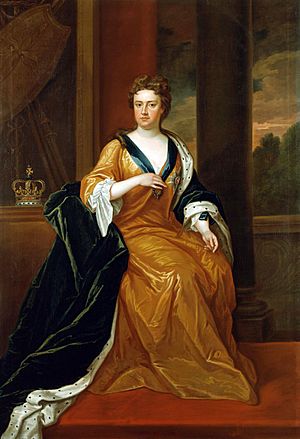
Anne became queen when King William III died on 8 March 1702. People liked her right away. In her first speech to Parliament, she said she was "entirely English." She promised to do everything for England's happiness.
Soon after becoming queen, Anne made her husband Lord High Admiral. This gave him control of the Royal Navy. Anne gave control of the army to Lord Marlborough. She made him Captain-General. Marlborough also received many honors from the Queen. His wife, the Duchess of Marlborough, also got important jobs.
Anne was crowned on 23 April 1702. Because of her gout, she was carried to Westminster Abbey in a special chair. On 4 May, England joined the War of the Spanish Succession. England, Austria, and the Dutch Republic fought against France and Spain. The war was about who would become the next king of Spain.
Queen Anne was very interested in how the country was run. She also supported theatre, poetry, and music. She gave money to the composer George Frideric Handel. She also ordered special medals for military achievements. She even knighted Isaac Newton when she visited Cambridge in 1705.
Uniting England and Scotland
Ireland was ruled by the English Crown. Wales was part of England. But Scotland was an independent country with its own parliament and laws. The Act of Settlement 1701 applied to England and Ireland, but not Scotland. In Scotland, many people wanted to keep the Stuart family on the throne.
Anne said it was "very necessary" to unite England and Scotland. A group from both countries met to talk about it in October 1702. But they could not agree. Scotland then passed the Act of Security. This law said that if Anne had no more children, Scotland could choose its next ruler. This person could not be the same person who became the English king or queen. This would only change if England allowed Scottish merchants to trade freely.
At first, Anne did not approve this law. But she did the next year. This was because the Scottish Parliament threatened to stop supporting England's wars.
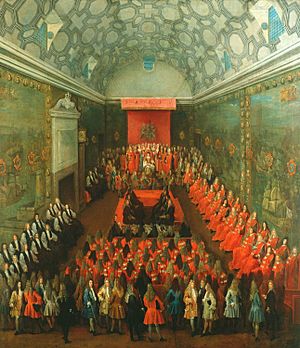
In response, the English Parliament passed the Alien Act 1705. This law threatened to punish Scotland economically. It also said Scottish people would be treated as foreigners in England. This would happen unless Scotland either removed its Act of Security or agreed to unite with England. Scotland chose to unite. New groups were chosen by Queen Anne in early 1706 to discuss the union.
The terms of the union were presented to Anne on 23 July 1706. Both the Scottish and English Parliaments approved them in early 1707. On 1 May 1707, England and Scotland became one kingdom called Great Britain. They would have one parliament. Anne strongly supported this union. She went to a special church service to celebrate. One person who was there wrote that "nobody on this occasion appeared more sincerely devout and thankful than the Queen herself."
Political Parties and Challenges
During Anne's reign, two main political parties grew stronger. The Tories generally supported the Anglican church. They also favored the landowners. The Whigs were more connected to businesses and Protestant groups who did not follow the Anglican church. Anne was a strong Anglican, so she usually preferred the Tories.
Her first government was mostly Tory. It included Lord Treasurer Lord Godolphin and the Duke of Marlborough. They were seen as moderate Tories.
Anne supported a bill called the Occasional Conformity Bill in 1702. The Tories wanted this bill. It aimed to stop Protestants who were not Anglican from holding public office. The current law allowed them to hold office if they took Anglican communion once a year. Anne's husband was a Lutheran, so he was an "occasional conformist" himself. Anne made him vote for the bill. The Whigs stopped the bill from passing.
The Whigs strongly supported the War of the Spanish Succession. They became even more powerful after the Duke of Marlborough won a big victory in 1704. Many of the Tories who did not want Britain to fight in the war were removed from their jobs. Godolphin, Marlborough, and Harley (who became Secretary of State) worked together. They had to rely more and more on the Whigs. Anne did not like the Whig leaders.
Sarah, the Duchess of Marlborough, kept bothering the Queen. She wanted Anne to appoint more Whigs. She also wanted Anne to reduce the power of the Tories. The Queen became more and more unhappy with the Duchess.
Anne started asking for private advice from Harley. He was not happy with Marlborough and Godolphin working more with the Whigs. She also turned to Abigail Hill, one of her ladies-in-waiting. Abigail's influence grew as Anne's friendship with Sarah got worse. Abigail was related to both Harley and the Duchess. But she was closer to Harley politically. She helped Harley and the Queen talk to each other.
The government faced a crisis on 8 February 1708. Godolphin and the Marlboroughs said Anne had to fire Harley or they would quit. When Anne hesitated, Marlborough and Godolphin refused to come to a meeting. Harley tried to lead the meeting without them. But others refused to work until they came back. Anne was forced to fire Harley.
The next month, Anne's Catholic half-brother, James Francis Edward Stuart, tried to invade Scotland with French help. He wanted to become king. Anne did not approve a bill to raise a Scottish army. She worried the army might support her half-brother. She was the last British ruler to stop a bill from becoming law. The invasion failed. Support for the Tories fell, and the Whigs won more seats in the 1708 election.
Loss and Change
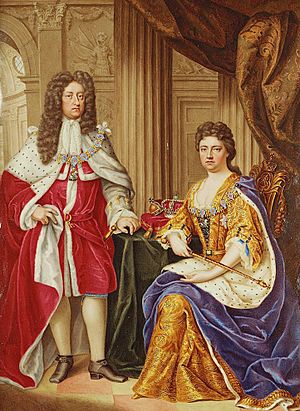
Anne was heartbroken when her husband died in October 1708. This was a turning point in her relationship with the Duchess of Marlborough. The Duchess arrived before George died. After his death, she insisted Anne leave Kensington Palace, even though Anne did not want to. Anne was upset by the Duchess's actions. The Duchess even removed a portrait of George from Anne's bedroom.
The Whigs used George's death to their advantage. They did not like how the navy was managed. They blamed Prince George and his deputy. With Whigs now in power in Parliament, they forced Anne to accept their leaders into her government. Anne, however, wanted to do the duties of Lord High Admiral herself. She did not want to appoint a government member to take George's place. The Whigs kept pushing. After more arguments, Anne finally agreed to put a Whig leader in charge of the navy in November 1709.
Sarah continued to complain to Anne about her friendship with Abigail. In October 1709, Anne wrote to the Duke of Marlborough. She asked that his wife "leave off teasing & tormenting me." On 6 April 1710, Anne and Sarah saw each other for the last time. Sarah said the Queen was quiet and formal. She kept repeating, "Whatever you have to say you may put in writing."
Ending the War
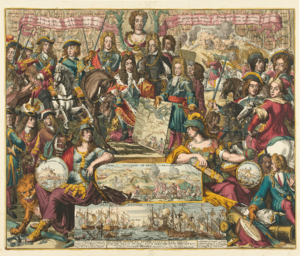
The War of the Spanish Succession was very expensive. People started to dislike it, and so they disliked the Whig government. A high-church Anglican, Henry Sacheverell, preached against the Whigs. He was put on trial, which made the public even more unhappy. Anne thought Sacheverell should be punished, but only lightly. She wanted to avoid more public trouble. Riots broke out in London to support Sacheverell. Anne ordered her guards to stop the riots. Sacheverell was found guilty, but his punishment was very light.
The Queen was growing more unhappy with the Marlboroughs and her government. She finally fired Sunderland in June 1710. Godolphin was fired in August. The Whig leaders were removed from their jobs. Marlborough, for a while, stayed as army commander. Anne appointed a new government led by Harley. This new government started to seek peace with France. Unlike the Whigs, Harley and his team were willing to let the French prince, Philip of Anjou, become King of Spain. In return, they wanted trade benefits.
In the elections that followed, Harley's party won a large Tory majority. In January 1711, Anne made Sarah resign her court jobs. Abigail took over an important role. Harley was stabbed by a French refugee in March. Anne cried, thinking he might die. He slowly got better. Godolphin died in September 1712. Anne cried again, blaming the Marlboroughs for their strained relationship.
The older brother of the other Spanish throne claimant died in April 1711. This meant he became the Holy Roman Emperor. Giving him the Spanish throne too was no longer good for Britain. A peace treaty was proposed. But the Whigs did not think it went far enough to stop French power. The Tories had a strong majority in the House of Commons. But they did not in the House of Lords. To get the peace treaty passed, Anne reluctantly created twelve new lords. This was a very unusual step. Abigail's husband was made a baron. On the same day, Marlborough was fired as commander of the army. The peace treaty was approved. Britain's part in the War of the Spanish Succession ended.
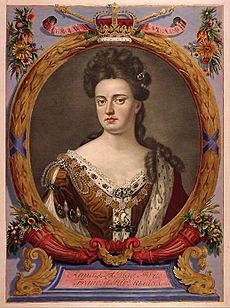
By signing the Treaty of Utrecht, the French King Louis XIV of France recognized the Hanoverian family as the next rulers of Britain. However, rumors continued that Anne and her ministers wanted her Catholic half-brother to be the next king. Anne denied these rumors. But she always refused to let any of the Hanoverian family visit England. Harley and another Tory minister also had secret talks with her half-brother about him possibly becoming king.
Death of Queen Anne
Anne could not walk between January and July 1713. At Christmas, she had a fever and was unconscious for hours. This led to rumors that she was dying. She got better, but was very sick again in March. By July, Anne had lost trust in Harley. Her secretary wrote that Anne told her government that Harley "neglected all business." She said he was hard to understand and that she could not trust what he said. She also said he was disrespectful to her.
On 27 July 1714, Anne fired Harley. Even though she was very sick, she went to two late-night government meetings. They could not decide who would replace Harley. A third meeting was canceled because she was too ill. She had a stroke on 30 July 1714. This was the anniversary of her son Gloucester's death. She could not speak. On the advice of her advisors, she gave the top government job to a Whig leader.
Anne died around 7:30 a.m. on 1 August 1714. She was buried next to her husband and children in Westminster Abbey on 24 August.
Who Ruled Next?
The Electress Sophia had died on 28 May, two months before Anne. So, Sophia's son, George, Elector of Hanover, became king. This was according to the Act of Settlement 1701. Other possible Catholic rulers, including Anne's half-brother, were not considered. George's rule was quite stable. A rebellion in 1715 failed. Marlborough got his job back, and Whig ministers replaced the Tories.
Queen Anne's Legacy
The Duchess of Marlborough wrote unkind things about Anne in her memoirs. For a long time, many historians believed these writings. They thought Anne was "a weak, undecided woman" who let personal arguments affect her decisions.
However, modern historians now see Anne more positively. Historian Edward Gregg wrote in 1980 that Anne was a very stubborn woman. She was the most important person of her time. Modern historians believe that old ideas about Anne being easily influenced or not interested in politics might come from old biases against women. Author David Green said, "Hers was not... government by women. She had great power."
Gregg concluded that Anne often got her way. Even though she was a woman in a male-dominated time and often sick, her reign saw ministers gain more influence. But the Crown's influence decreased. She went to more government meetings than any ruler before or after her. Her reign was a time of great progress in art, writing, science, business, and politics. This was possible because her rule was stable and prosperous.
Famous buildings like Blenheim Palace and Castle Howard were built. Writers like Daniel Defoe and Jonathan Swift became popular. New gardens were designed. The union of England and Scotland, which Anne strongly supported, created Europe's largest free trade area. Anne's governments achieved much in politics and diplomacy. There were no big fights between the queen and Parliament during her reign. This shows she chose her ministers wisely and used her powers well.
Titles and Symbols
Titles and Styles
- 6 February 1665 – 28 July 1683: Her Highness The Lady Anne
- 28 July 1683 – 8 March 1702: Her Royal Highness The Princess Anne of Denmark
- 8 March 1702 – 1 August 1714: Her Majesty The Queen
Before 1707, Anne's official title was "Anne, by the Grace of God, Queen of England, Scotland, France and Ireland, Defender of the Faith, etc." After England and Scotland united, her title changed. It became "Anne, by the Grace of God, Queen of Great Britain, France and Ireland, Defender of the Faith, etc." Like other English monarchs, she was called "Queen of France." But she did not actually rule France.
Royal Arms
As queen, Anne used the royal coat of arms of the Stuart family. These arms had been used since 1603. They showed symbols for France, England, Scotland, and Ireland. In 1702, Anne chose the motto semper eadem, which means "always the same." This was the same motto used by Queen Elizabeth I.
After the union in 1707, the symbols for England and Scotland were placed side by side in the same section of the shield. This showed they were now one kingdom.
| Coat of arms of Anne as Princess of Denmark | Coat of arms of Anne as Queen of England from 1702 to 1707 | Coat of arms of Anne as Queen of Great Britain from 1707 to 1714 |
Pregnancies and Issue
Queen Anne had 17 pregnancies. Five of her children were born alive. Sadly, none of them lived to be adults. Her only child to live past infancy was Prince William, Duke of Gloucester, who died at age 11.
See Also
 In Spanish: Ana de Gran Bretaña para niños
In Spanish: Ana de Gran Bretaña para niños
- Early-18th-century Whig plots
- Queen Anne's Bounty, 1704 financial scheme in support of poorer clergy
- Queen Anne's Revenge, 18th-century pirate ship


